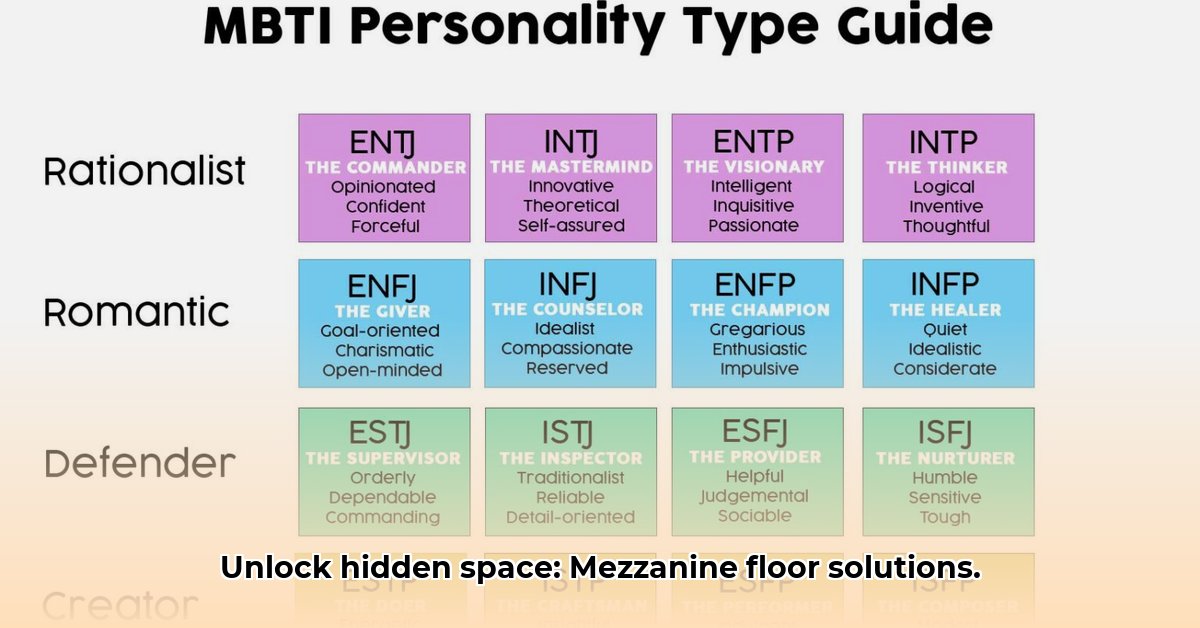Need more space but don’t want to build an addition? A mezzanine floor might be your answer! They’re a clever way to add extra room without the hassle and high cost of expanding your building. But with different types – steel, wood, concrete, and even combinations – choosing the right one can feel confusing. This guide makes it easy. We’ll break down each type, comparing prices and benefits, walking you through installation step-by-step, and giving you tips on finding the right installer. We’ll even show you how to make sure your mezzanine works perfectly for years to come, maximizing your space and saving you money. For a quick overview, check out this helpful article on [mezzanine floors](https://www.wavesold.com/what-is-a-mezzanine-floor). Let’s get started and find the perfect mezzanine for your needs!
Understanding Mezzanine Floors: A Comprehensive Guide to Space Optimization
Mezzanine floors offer a practical and cost-effective way to expand usable space within an existing structure. They are intermediate platforms installed between the main floor and the ceiling, effectively creating an additional level without the need for costly and disruptive building expansions. Ideal for warehouses, retail spaces, offices, and even residential properties, mezzanines can significantly enhance functionality and optimize space utilization.
Types of Mezzanine Floors: Maximizing Your Space with Smart Solutions
When considering a mezzanine floor, understanding the different types available is crucial for selecting the option that best suits your specific requirements. Each type offers unique advantages in terms of load capacity, aesthetics, installation, and cost. Let’s explore the most common mezzanine floor types:
Steel Mezzanine Floors: Strength and Versatility for Industrial Applications
Steel mezzanine floors are renowned for their exceptional strength, durability, and versatility, making them a popular choice for industrial and commercial applications. Constructed from structural steel components, these mezzanines can support heavy loads, withstand demanding environments, and provide a long-lasting solution for maximizing space.
Pros:
- High Load Capacity: Steel mezzanines can handle significant weight, making them ideal for storing heavy equipment, machinery, or large volumes of inventory.
- Durable and Long-Lasting: Steel is a robust material that can withstand wear and tear, ensuring a long service life for the mezzanine floor.
- Customizable Designs: Steel mezzanines can be easily customized to fit specific space requirements and accommodate unique layouts.
- Relatively Quick Installation: Compared to concrete mezzanines, steel mezzanines can be installed more quickly, minimizing disruption to operations.
- Fire Resistance: Steel is inherently fire-resistant, providing an added layer of safety.
Cons:
- Higher Initial Cost: Steel mezzanines typically have a higher upfront cost compared to wood or composite options.
- Industrial Appearance: The industrial aesthetic of steel may not be suitable for all environments, particularly office or retail spaces where aesthetics are a primary concern.
- Potential for Corrosion: Steel is susceptible to rust and corrosion, especially in humid or corrosive environments, requiring protective coatings and regular maintenance.
Concrete Mezzanine Floors: Robust Strength and Fire Resistance for Demanding Environments
Concrete mezzanine floors offer unparalleled strength, durability, and fire resistance, making them the preferred choice for heavy-duty industrial applications and environments where safety is paramount. These mezzanines are constructed from reinforced concrete slabs, providing a solid and stable platform capable of withstanding extreme loads and harsh conditions.
Pros:
- Exceptional Strength and Durability: Concrete mezzanines can support extremely heavy loads and withstand significant impact, making them ideal for demanding industrial environments.
- Superior Fire Resistance: Concrete is inherently fireproof, providing exceptional protection against fire hazards.
- Excellent Soundproofing: Concrete offers excellent sound insulation, reducing noise transmission between levels.
- Long Lifespan: Concrete mezzanines have a very long lifespan, requiring minimal maintenance.
- Moisture Resistance: Concrete is resistant to moisture and humidity, making it suitable for damp environments.
Cons:
- High Initial Cost: Concrete mezzanines are the most expensive option, requiring significant investment.
- Complex and Time-Consuming Installation: Installation is more complex and time-consuming compared to other types, potentially disrupting operations.
- Heavy Weight: Concrete is a heavy material, requiring strong structural support and potentially reinforcing the existing building structure.
- Limited Design Flexibility: Concrete mezzanines offer less design flexibility compared to steel or wood options.
Wood Mezzanine Floors: Aesthetic Appeal and Cost-Effectiveness for Light-Duty Applications
Wood mezzanine floors provide a cost-effective and aesthetically pleasing alternative for light-duty applications, such as offices, retail spaces, and residential properties. Constructed from timber joists and wooden decking, these mezzanines offer a warm and inviting aesthetic that complements a variety of interior designs.
Pros:
- Visually Appealing: Wood mezzanines add warmth and character to a space, creating a more inviting atmosphere.
- Cost-Effective: Wood is a relatively inexpensive material, making wood mezzanines a budget-friendly option.
- Easy and Quick Installation: Wood mezzanines are relatively easy and quick to install, minimizing disruption to operations.
- Lightweight Construction: Wood is a lightweight material, reducing the load on the existing building structure.
Cons:
- Lower Load Capacity: Wood mezzanines have a lower load-bearing capacity compared to steel or concrete, limiting their use to light-duty applications.
- Susceptible to Damage: Wood is susceptible to damage from moisture, fire, and insects, requiring regular maintenance and protection.
- Requires Regular Maintenance: Wood mezzanines require regular maintenance, such as sealing, staining, or painting, to prevent deterioration.
Composite Mezzanine Floors: Combining Strength and Aesthetics for Customized Solutions
Composite mezzanine floors combine the strengths of different materials, typically steel and wood, to create a customized solution that balances strength, aesthetics, and cost. These mezzanines often feature steel beams for structural support and wood or composite decking for a more visually appealing finish.
Pros:
- Combines Strengths of Different Materials: Composite mezzanines offer the strength and durability of steel with the aesthetic appeal of wood.
- Customizable Designs: Composite mezzanines can be customized to meet specific design requirements and functional needs.
- Good Balance Between Cost and Durability: Composite mezzanines offer a good balance between cost, durability, and aesthetics.
Cons:
- Complex Design and Construction: Design and construction require careful planning and expertise to ensure proper integration of materials.
- Cost Can Vary Widely: The cost of composite mezzanines can vary widely depending on the materials selected and the complexity of the design.
Rack-Supported Mezzanine Floors: Utilizing Existing Infrastructure for Cost Savings in Warehouses
Rack-supported mezzanine floors offer a cost-effective solution for maximizing space in warehouses and storage facilities. These mezzanines utilize existing racking systems as the primary structural support, eliminating the need for separate support columns and reducing construction costs.
Pros:
- Cost-Effective: Rack-supported mezzanines are a cost-effective option, utilizing existing racking systems to reduce construction costs.
- Quicker Installation: Installation is typically quicker compared to other types of mezzanines, minimizing disruption to operations.
- Efficient Use of Space: Rack-supported mezzanines maximize space utilization by integrating the mezzanine structure with the existing racking system.
Cons:
- Limited Flexibility: Design and placement are limited by the existing racking system.
- Lower Load Capacity: Rack-supported mezzanines typically have a lower load capacity compared to other types.
- Not Suitable for All Racking Systems: Rack-supported mezzanines may not be suitable for all racking systems or load requirements.
Choosing the Right Mezzanine: Key Factors to Consider for Your Specific Needs
Selecting the right type of mezzanine floor requires careful consideration of several key factors to ensure that the chosen option meets your specific needs and budget.
- Load Capacity: Determine the maximum weight that the mezzanine will need to support, including the weight of occupants, equipment, and stored materials.
- Budget: Establish a realistic budget for the mezzanine project, considering material costs, labor expenses, and permit fees.
- Aesthetics: Consider the desired aesthetic of the mezzanine and choose a material that complements the surrounding environment.
- Fire Safety Regulations: Ensure that the chosen mezzanine material meets all applicable fire safety regulations and building codes.
- Installation Time and Complexity: Evaluate the installation time and complexity associated with each type of mezzanine, considering potential disruptions to operations.
- Building Codes and Permits: Research local building codes and permit requirements to ensure compliance.
- Intended Use: Determine the primary purpose of the mezzanine, whether it’s for storage, office space, production, or retail.
Mezzanine Floor Installation: A Step-by-Step Guide (General Overview)
Installing a mezzanine floor is a complex process that requires careful planning, professional expertise, and adherence to safety regulations. While the specific steps may vary depending on the type of mezzanine and the site conditions, the general process typically involves the following stages:
- Planning and Design: Engage a qualified engineer or contractor to assess your space, develop a detailed design, and ensure compliance with building codes.
- Permits and Approvals: Obtain all necessary building permits and approvals from local authorities.
- Structural Engineering Verification: Have a structural engineer verify that the design meets all applicable building codes and load requirements.
4.
- Glass Tile Shower Ideas to Create a Stunning Bathroom Space - December 7, 2025
- Glass Wall Tile Ideas for Kitchens and Bathrooms - December 6, 2025
- Glass Tile Bathroom: Create a Beautiful, Easy-Clean Space - December 5, 2025










